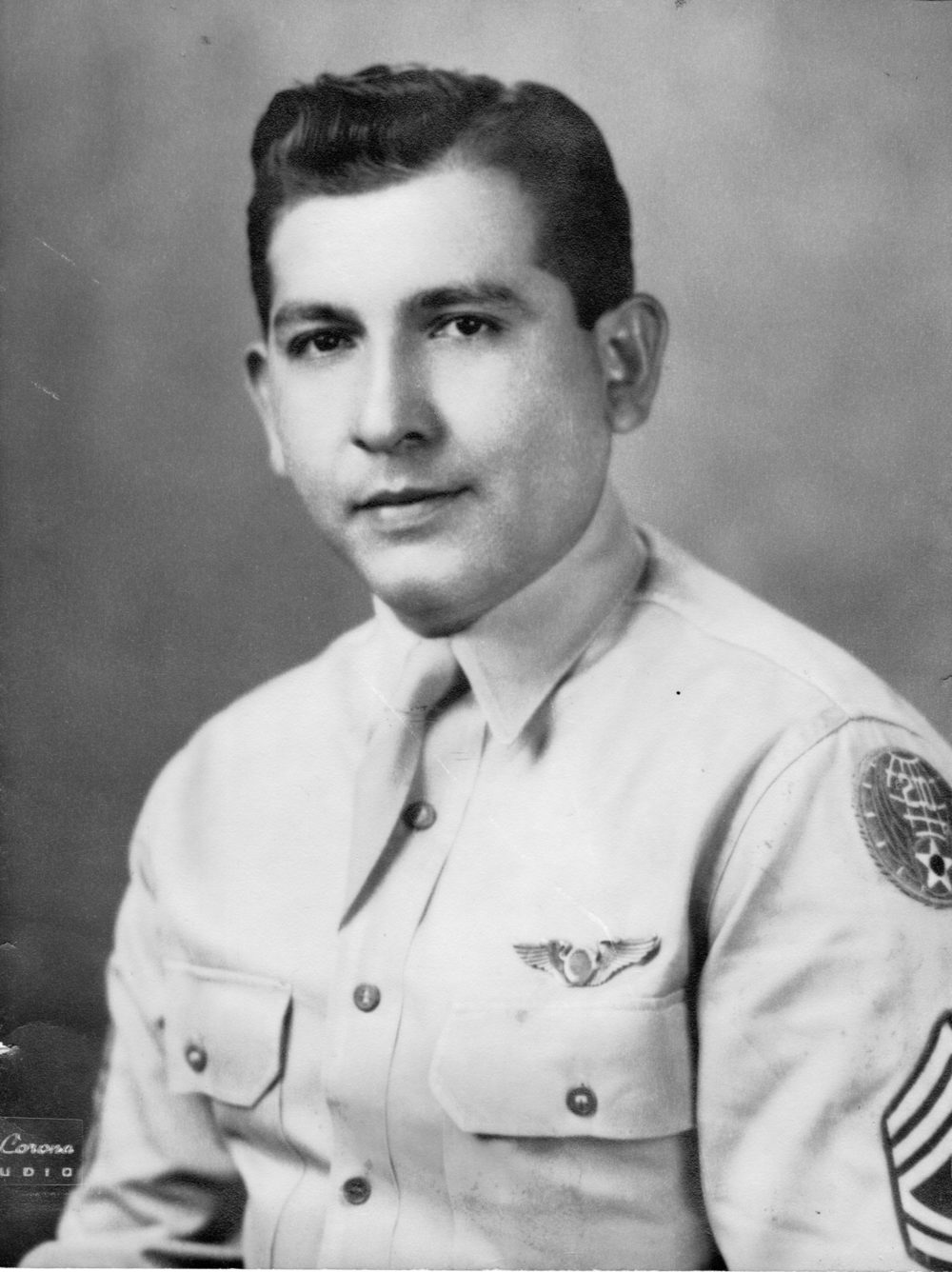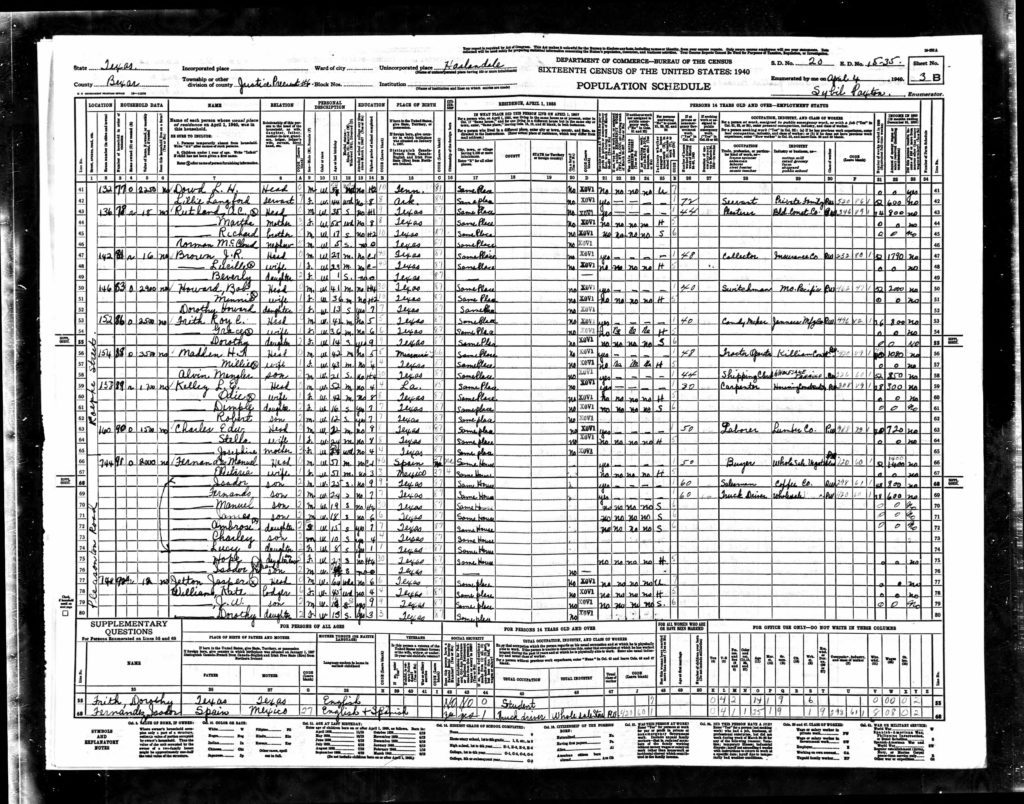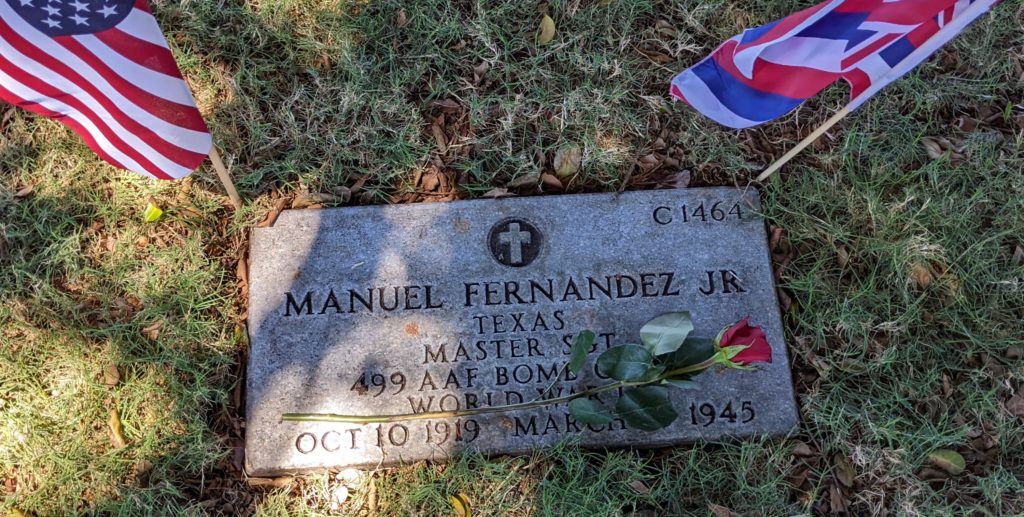Master Sergeant Manuel Fernandez, Jr.

- Unit: 499th Army Air Force Bombardment Group
- Service Number: 18056417
- Date of Birth: October 10, 1919
- Entered the Military: July 2, 1941
- Date of Death: March 25, 1945
- Hometown: San Antonio, Texas
- Place of Death: Yokohama, Japan
- Cemetery: Section C, Grave 1464. National Memorial Cemetery of the Pacific, Honolulu, Hawaiʻi
Mentored by Mr. Rhett D. Carter
Plano East Senior High School
2021–2022
Early Life
Manuel Fernandez, Jr. was born in San Antonio, Texas, on October 10, 1919 and was one of seven siblings. His father, Manuel Fernandez, Sr., immigrated from Spain, and his mother, Electaria Fernandez, immigrated from Mexico. A strong student, Fernandez became the first member of his family to earn his high school diploma. With a bright future ahead of him, Fernandez became a salesman at the Washington National Insurance Company in San Antonio.

Census. National Archives and Records Administration.
Homefront
By 1940, San Antonio had become one of the fastest-growing cities in Texas. The cityscape boasted cinemas, malls, and mass consumerism, which had taken root during the Roaring Twenties. During World War II, the Texas League organized minor-league baseball teams in San Antonio to raise Texans’ morale.
Aviation in San Antonio
San Antonio’s clear skies enabled the U.S. Army Air Forces to hold training programs and enlist pilots. In 1941, the city established the San Antonio Aviation Cadet Center (now Lackland Air Force Base) and repurposed Fort Sam Houston as a complex for U.S. Army medical training. The famous Stinson family pioneered Texas aviation, and they established the Stinson School of Flying in 1915. This set a precedent that would eventually lead to the establishment of Kelly Field, Brooks Field, and Camp Travis (later absorbed by Fort Sam Houston), which trained pilots like Fernandez during the course of the war.

Military Experience
When Fernandez enlisted as a private at Fort Sam Houston on July 2, 1941, he trained as a pilot for the 499th United States Army Air Force Bomb Group and later transferred to Adams Field in Arkansas. In Arkansas, Fernandez married Esther Odessa Clawson on July 26, 1943, at age 23. While training, Fernandez and his group expected to deploy in England. However, in the wake of the Allied victory at the Battle of Bismarck Sea (March 2–4, 1943), Major General George C. Kenney requested that the U.S. Army Air Forces send the group instead to the Southwest Pacific.
Thus, Fernandez campaigned through Saipan, the Truk Islands, and Iwo Jima with his fellow pilots, earning a promotion to master sergeant. By March 1945, he had engaged in firebombing and leaflet campaigns over the Japanese island of Honshu.
Final Campaigns
Throughout his campaign, Fernandez bravely piloted a North American B-25 Mitchell, introduced in 1941 to target Axis military installations in New Guinea and the Philippines. These preemptive infrastructure strikes protected the lives of an untold number of his fellow American troops. On the fateful March 25, 1945, Fernandez was killed in action while conducting an incendiary air raid over Yokohama, Japan.


Eulogy
The life of Fernandez teaches us to dedicate only our strongest efforts during the harshest of tribulations. From the bustling plazas of San Antonio to the expansive stretches of the South Pacific, he demonstrated that bravery is always an option.
In 1943, the year Fernandez took his final step on American soil, President Franklin Delano Roosevelt remarked, “We have faith that future generations will know here, in the middle of the twentieth century, there came a time when men of good will found a way to unite, and produce, and fight to destroy the forces of ignorance, and intolerance, and slavery, and war.”
To Roosevelt’s triumph, the future generations do remember the sacrifices for freedom made on the beaches, in the cities, and over the open ocean nearly a century ago. Now, we stand in honor of Master Sergeant Manuel Fernandez, Jr., a great American and a Silent Hero.

Reflection
Researching the life of Master Sergeant Manuel Fernandez, Jr. required me to parse deeply through government records and sources from Fernandez’s bomb group. After reconstructing Fernandez’s life through extensive investigation, I believe my teacher and I have taken our next steps as historians. This Silent Hero research process increased my confidence in historical chronicling with real-world applications in recovering the past.
Reciting Fernandez’s eulogy at the National Memorial Cemetery of the Pacific was a culmination of half a year of effort in honor of a fallen hero. This experience with Sacrifice for Freedom® has taught me that history is much like science in that both disciplines generate active discovery. Perhaps this motif of discovery extends beyond those two fields. Moving forward, I will remain cognizant of chances to uncover new stories as an active historian and scholar. I hope to recover and retell the fascinating lives of more individuals as a lifelong passion.
Bibliography
Primary Sources
Fernandez-Clawson Marriage Certificate. Arkansas, Marriage Certificates, 1917-1969. Digital Images. http://ancestry.com.
Manuel Fernandez. Texas, U.S., Birth Certificates, 1903-1932. Digital Images. http://ancestry.com.
Manuel Fernandez, Jr. Photograph. c. 1941-1945. Courtesy of Isadoro Fernandez. http://ancestry.com.
Manuel Fernandez, Jr. World War II and Korean Conflict Veterans Interred Overseas. http://ancestry.com.
Manuel Fernandez, Jr. World War II Army Enlistment Records, 1938-1946. http://ancestry.com.
Manuel Fernandez, Jr. World War II Draft Cards Young Men, 1940-1947. Digital Images. http://ancestry.com.
Texas. Bexar County. 1920 U.S. Federal Census. Digital Images. http://ancestry.com.
Texas. Bexar County. 1930 U.S. Federal Census. Digital Images. http://ancestry.com.
Texas. Bexar County. 1940 U.S. Federal Census. Digital Images. http://ancestry.com.
War Heroes Day parade, viewed from Majestic Theater, San Antonio, Tex., 1942. Photograph. July 1, 1942. San Antonio Light Photograph Collection, University of Texas at San Antonio Libraries Special Collections (L-2983-E). digital.utsa.edu/digital/collection/p9020coll2/id/1263/.
Secondary Sources
“499th Bombardment Group.” Army Air Corps Library and Museum. Last modified April 26, 2018. Accessed October 24, 2022. www.armyaircorpsmuseum.org/499th_Bombardment_Group.cfm.
“Discover Your Cultural Heritage.” Texas Time Travel, Texas Historical Commission. Accessed August 18, 2022. txhillcountrytrail.com/node/28769.
Jasinski, Laurie E. “San Antonio, TX.” Texas State Historical Association. Last modified July 30, 2022. Accessed October 24, 2022. www.tshaonline.org/handbook/entries/san-antonio-tx.
“Manuel Fernandez, Jr.” National Cemetery Administration. Accessed October 24, 2022. gravelocator.cem.va.gov/ngl/index.jsp.
“MSGT Manuel Fernandez Jr.” Find a Grave. Accessed October 24, 2022. www.findagrave.com/memorial/3774499/manuel-fernandez.
“North American B-25 Mitchell.” The National WWII Museum. Accessed August 18, 2022. www.nationalww2museum.org/visit/museum-campus/us-freedom-pavilion/warbirds/north-american-b-25-mitchell.
Peppy Blount, R.E. “Brief Unit History.” 345th Bomb Group Association. Accessed August 18, 2022. www.345thbombgroup.org/history_index.php.
“San Antonio, Texas Population History.” Top 100 Biggest U.S. Cities By Population. Last modified May 27, 2022. Accessed October 24, 2022. www.biggestuscities.com/city/san-antonio-texas.
“Texas in World War II.” Texas Historical Commission. Last modified March 12, 2021. Accessed October 24, 2022. www.thc.texas.gov/preserve/projects-and-programs/military-sites/texas-world-war-ii.
Texas Historical Commission. Texas in World War II. Austin: Texas Historical Commission, 2005.

